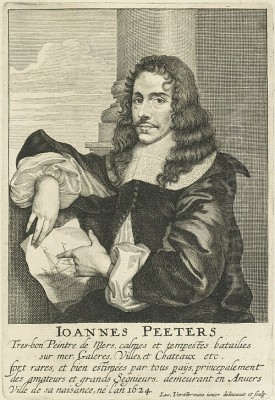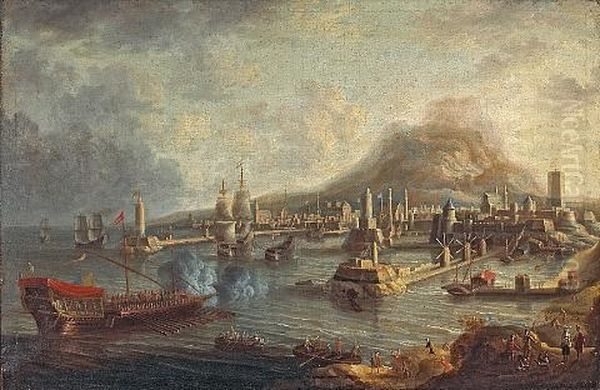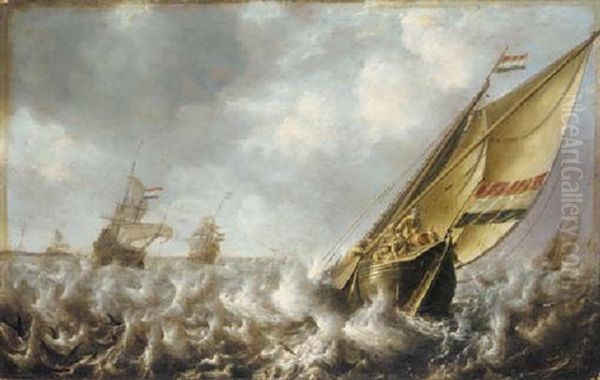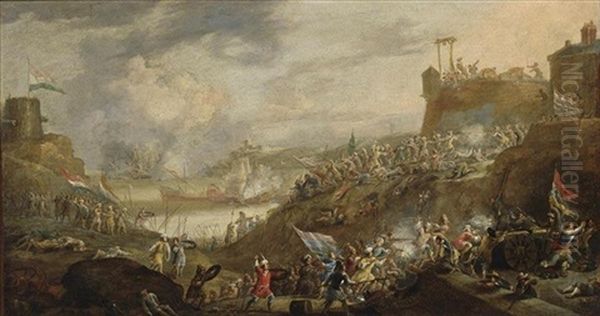
Jan Peeters the Elder, also known as Jan Peeters I, stands as a significant figure in the rich tapestry of Flemish Baroque art. Born in the bustling artistic hub of Antwerp on April 24, 1624, and passing away in the same city between September 1677 and February 1678, Peeters carved a distinct niche for himself as a painter, draughtsman, and etcher, primarily celebrated for his evocative marine subjects, topographical views, and dramatic shipwreck scenes. His work not only captured the maritime spirit of the age but also contributed to the enduring legacy of the Peeters artistic dynasty.
Early Life and Artistic Lineage
Jan Peeters I was born into a family deeply immersed in the world of art. His parents were Cornelis Peeters and Catharina van Eelen. The Peeters family was a veritable artistic force in Antwerp, with several members achieving recognition as painters. This familial environment undoubtedly provided Jan with an early and profound exposure to artistic techniques and traditions. He was the brother of other notable artists: Gillis Peeters the Elder (1612–1653), a landscape and marine painter; Bonaventura Peeters the Elder (1614–1652), arguably the most famous marine painter of the family and a crucial influence on Jan; and Catharina Peeters (1615–1676), who also specialized in marine paintings and still lifes.
This artistic upbringing meant that Jan Peeters I was likely apprenticed within the family circle, a common practice in 17th-century Antwerp. His elder brother, Bonaventura Peeters the Elder, was a particularly strong guiding force. Bonaventura had already established himself as a leading marine artist by the time Jan was developing his skills. The shared subjects and, at times, stylistic similarities between their works attest to a close artistic relationship, likely involving direct tutelage or at least shared studio practices. Jan Peeters I became a master in the Antwerp Guild of Saint Luke in 1645, a formal recognition of his status as an independent artist.
Artistic Development and Influences

While the Peeters family tradition, especially the work of Bonaventura the Elder, formed the bedrock of Jan's artistic education, his style also absorbed broader influences. The 17th century was a golden age for marine painting, particularly in the Low Countries. Dutch artists like Jan Porcellis, Simon de Vlieger, and later Willem van de Velde the Elder and Willem van de Velde the Younger were revolutionizing the genre with their atmospheric depictions of the sea, sky, and shipping. Peeters would have been aware of these developments, and his work often reflects a similar concern for realistic light effects and meteorological accuracy, albeit filtered through a distinctly Flemish sensibility.
The Flemish Baroque, spearheaded by titans like Peter Paul Rubens and Anthony van Dyck, emphasized dynamism, rich color, and dramatic compositions. While Peeters' subjects were more specialized, the ambient artistic climate of Antwerp, with its emphasis on technical virtuosity and expressive power, certainly left its mark. He also collaborated with other artists, a common practice in Antwerp. For instance, he is known to have painted staffage (figures) in the landscapes of other painters, and conversely, other artists may have contributed figures or specific elements to his compositions. His nephew, Bonaventura Peeters the Younger (1648-1702), son of Gillis, also became a marine painter, continuing the family tradition.
Style and Thematic Focus
Jan Peeters the Elder is best known for his marine paintings, which encompass a wide range of subjects. These include tranquil harbor scenes, ships navigating calm or choppy waters, naval battles, and, perhaps most strikingly, dramatic shipwrecks. His seascapes are characterized by a keen observation of maritime life and the natural world. He possessed a remarkable ability to render the intricate details of various types of vessels, from humble fishing boats to imposing warships, capturing their rigging and structure with precision.
His depictions of storms and shipwrecks are particularly noteworthy for their dramatic intensity. In these works, Peeters masterfully conveyed the power of nature and the vulnerability of humankind against the elements. Crashing waves, windswept skies, and ships foundering on rocks are rendered with a sense of immediacy and pathos. These scenes resonated with a contemporary audience familiar with the perils of sea travel and the economic importance of maritime trade.

Beyond purely marine subjects, Peeters also excelled in topographical views. He produced numerous paintings and drawings depicting specific coastal towns, harbors, and landscapes, often with an almost cartographic accuracy. Many of these views were of locations far beyond Flanders, including scenes from the Mediterranean, the Levant, and North Africa. It is believed that some of these were based on his own travels, while others may have been derived from sketches made by other artists or from published prints and descriptions. This interest in exotic locales added a distinctive dimension to his oeuvre. His palette could range from a more subdued, tonal approach reminiscent of Dutch "tonal phase" painters to more colorful and dramatic effects, particularly in his storm scenes.
Notable Works
Several works exemplify Jan Peeters the Elder's skill and thematic concerns. While a comprehensive list is extensive, some representative titles often associated with him or his characteristic style include:
"Shipping in a Calm Sea": Demonstrating his ability to capture serene maritime moments with meticulous detail in the vessels and a subtle rendering of light and water.
"A Shipwreck on a Rocky Coast": A classic example of his dramatic shipwreck scenes, showcasing turbulent seas, shattered ships, and desperate survivors, highlighting the sublime power of nature.
"View of Antwerp from the River Scheldt": Such topographical views were a significant part of his output, displaying his skill in rendering cityscapes and harbor activities with accuracy.
"Mediterranean Harbor Scene with Oriental Figures": Reflecting his interest in exotic locales, these paintings often featured bustling ports with diverse shipping and figures in distinctive attire, appealing to the contemporary taste for the exotic.
"Dutch Ships in a Storm": These works often emphasize the dramatic interplay of light and shadow across tumultuous waves and dark storm clouds, with ships battling the elements.
"The Southern Coast": Likely a depiction of a Mediterranean or Levantine coastal scene, showcasing his ability to evoke a sense of place.
"A Bay Scene in a Breeze": Capturing the more everyday aspects of maritime life, with ships under sail in moderate weather.
"The Great Flood": While the specific subject might refer to a biblical or historical event, it would undoubtedly allow Peeters to display his mastery in depicting water and dramatic scenes.
"The Mediterranean Port of Entry": Another example of his topographical and exotic port scenes.
"A Sea Voyage in a Breeze" and "A Sea Voyage in a Storm": Titles that clearly indicate his range in depicting varying weather conditions and their impact on seafaring.
"Athlone Castle": This work, held in the National Gallery of Ireland, demonstrates his skill in topographical depiction, extending beyond purely coastal scenes.

His drawings and etchings also form an important part of his legacy, often displaying a more spontaneous touch or serving as preparatory studies for paintings. Many of his drawings were intended as finished works of art in their own right.
The Peeters Family Workshop and Collaborations
The concept of the family workshop was central to artistic production in 17th-century Antwerp. The Peeters family was no exception. Jan likely worked in close proximity to his siblings, particularly Bonaventura the Elder, Gillis the Elder, and Catharina. This environment fostered a shared visual language and technical approach, though each artist developed their individual strengths. It is plausible that they collaborated on larger commissions or shared studio resources.
The collaborative spirit extended beyond the family. Antwerp's art scene was characterized by specialization, and it was common for artists to collaborate on a single painting. A landscape painter might enlist a figure specialist, or an architectural painter might have a marine artist add ships to a canal scene. While specific documented collaborations involving Jan Peeters I with artists outside his family are not always extensively detailed, the practice was widespread. His own versatility in depicting both ships and landscapes, however, might have made him less reliant on such collaborations for the core elements of his marine paintings. The influence of other Antwerp artists, such as the genre scenes of David Teniers the Younger or the broader landscape tradition stemming from artists like Jan Brueghel the Elder, would have formed part of the artistic milieu in which Peeters operated.
Travels and Depictions of Distant Lands
A fascinating aspect of Jan Peeters the Elder's work is his depiction of numerous locations outside of the Low Countries. He produced a significant body of work, including paintings, drawings, and prints, illustrating coastal towns, fortresses, and landscapes in the Mediterranean, the Levant (the historical region of Syria, Lebanon, Israel, Palestine, and Jordan), and even North Africa. Titles like "View of Algiers," "Port of Smyrna," or "Coastal Scene near Tripoli" are indicative of this interest.
The question of whether Peeters personally visited all these locations is a subject of art historical discussion. Some scholars believe he undertook extensive travels, possibly in the late 1640s or 1650s. The detail and apparent accuracy in some of these views lend credence to this idea. Sea travel was arduous and dangerous, but not uncommon for artists seeking new subjects or patronage.
Alternatively, it is also possible that many of these depictions were based on sketches made by other travelers, such as merchants, diplomats, or other artists, or derived from existing prints and maps. The demand for images of exotic lands was high in 17th-century Europe, fueled by trade, exploration, and a general curiosity about the wider world. Regardless of the extent of his personal travels, Peeters demonstrated a remarkable ability to synthesize information and create convincing and engaging portrayals of these distant shores. These works distinguish him from many of his contemporaries who focused primarily on local waters. His series of etchings, often published in sets, further disseminated these views to a wider audience.
Later Life and Legacy
Jan Peeters the Elder remained active in Antwerp throughout his career. Unlike his brother Bonaventura, who died relatively young in 1652, Jan enjoyed a longer career, allowing him to produce a substantial body of work. Information about his personal life is somewhat scarce, as is common for many artists of the period. He is not known to have married or had children. He continued to live and work in Antwerp, a city that, despite facing economic challenges in the latter half of the 17th century, remained an important center for the arts.
He passed away in Antwerp, likely in late 1677 or early 1678. His legacy is that of a skilled and versatile marine and topographical artist who successfully blended Flemish Baroque dynamism with a keen eye for detail and atmospheric effects. He contributed significantly to the genre of marine painting and provided valuable visual records, or imaginative reconstructions, of numerous coastal locations.
His influence can be seen in the work of later marine painters in the Southern Netherlands. The Peeters family, as a whole, played a crucial role in establishing marine painting as a respected genre within Flemish art. While perhaps not as internationally renowned as some of his Dutch contemporaries like Willem van de Velde the Younger or Ludolf Bakhuizen, Jan Peeters the Elder holds an important place in the history of Flemish art. His works are valued for their artistic merit, their historical documentation of maritime life and specific locations, and their embodiment of the Baroque era's fascination with the sea.
The Context of Flemish and Dutch Marine Painting
To fully appreciate Jan Peeters the Elder's contribution, it is essential to understand the broader context of 17th-century marine painting. The Dutch Republic, with its vast global trade network and powerful navy, saw an explosion in the popularity of marine art. Artists like Hendrick Cornelisz Vroom, Jan Porcellis, Simon de Vlieger, Jan van Goyen (who painted river and estuary scenes with marine characteristics), Abraham Storck, and the aforementioned Van de Veldes and Bakhuizen, created a rich and varied tradition. They excelled in capturing the nuances of light, weather, and water, from calm, reflective surfaces to raging storms.
In the Southern Netherlands (Flanders), while perhaps not as prolific as in the North, marine painting also flourished. Early pioneers included Andries van Eertvelt, who brought a more dramatic, Mannerist-influenced style. The Peeters family, particularly Bonaventura the Elder and Jan the Elder, were central to the development of Flemish marine art in the Baroque period. They often infused their seascapes with a greater sense of drama and richer color than their more restrained Dutch counterparts, aligning with broader Flemish Baroque tendencies. Other Flemish artists who touched upon marine themes included Gaspar van Eyck. The demand for such paintings came from wealthy merchants, naval officers, and civic institutions, all keen to celebrate maritime prowess, commemorate naval victories, or simply appreciate the beauty and power of the sea. Clara Peeters, another prominent Antwerp artist (though no direct relation, and primarily a still life painter), exemplifies the high level of skill present in the city during this era.
Collecting and Market Presence
Works by Jan Peeters the Elder have been sought after by collectors since his own lifetime and continue to be appreciated today. His paintings, drawings, and prints can be found in numerous public and private collections across the world. Museums such as the National Maritime Museum in Greenwich, London, the Rijksmuseum in Amsterdam, the Royal Museums of Fine Arts of Belgium in Brussels, and various regional museums in Belgium and the Netherlands hold examples of his work. His "Athlone Castle" is a notable piece in the National Gallery of Ireland.
The market value of his works, like those of many Old Masters, can vary depending on factors such as size, condition, subject matter, provenance, and the prevailing trends in the art market. His dramatic shipwreck scenes and detailed topographical views of identifiable locations, especially those of exotic ports, are often particularly prized. While specific auction records for Jan Peeters I might not always make headlines in the same way as those for the very top tier of Old Masters like Rubens or Rembrandt, his works appear regularly at auctions specializing in Old Master paintings and drawings, commanding respectable prices that reflect his skill and historical importance. The enduring appeal of marine art, combined with Peeters' technical proficiency and the intriguing nature of his subjects, ensures his continued relevance in the art world.
Conclusion
Jan Peeters the Elder was a distinguished and prolific artist of the Flemish Baroque, whose specialization in marine and topographical subjects set him apart. Born into an artistic dynasty, he absorbed the influences of his family, particularly his brother Bonaventura, while also engaging with the broader trends in Dutch and Flemish art. His ability to capture both the serene beauty and the terrifying power of the sea, coupled with his meticulous rendering of ships and his fascinating depictions of distant lands, secured him a lasting reputation.
His oeuvre provides a captivating window into the maritime world of the 17th century, reflecting the era's spirit of exploration, trade, and naval conflict. As a painter, draughtsman, and etcher, Jan Peeters I made a significant contribution to the rich tradition of marine art in the Low Countries, and his works continue to be admired for their technical skill, dramatic impact, and historical interest. He remains a testament to the depth and diversity of talent that flourished in Antwerp during its golden age of painting.